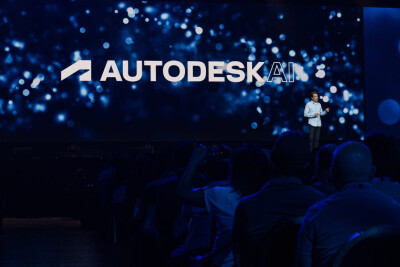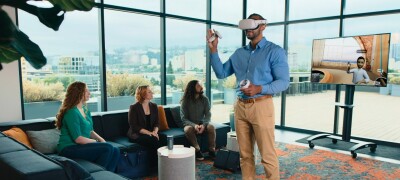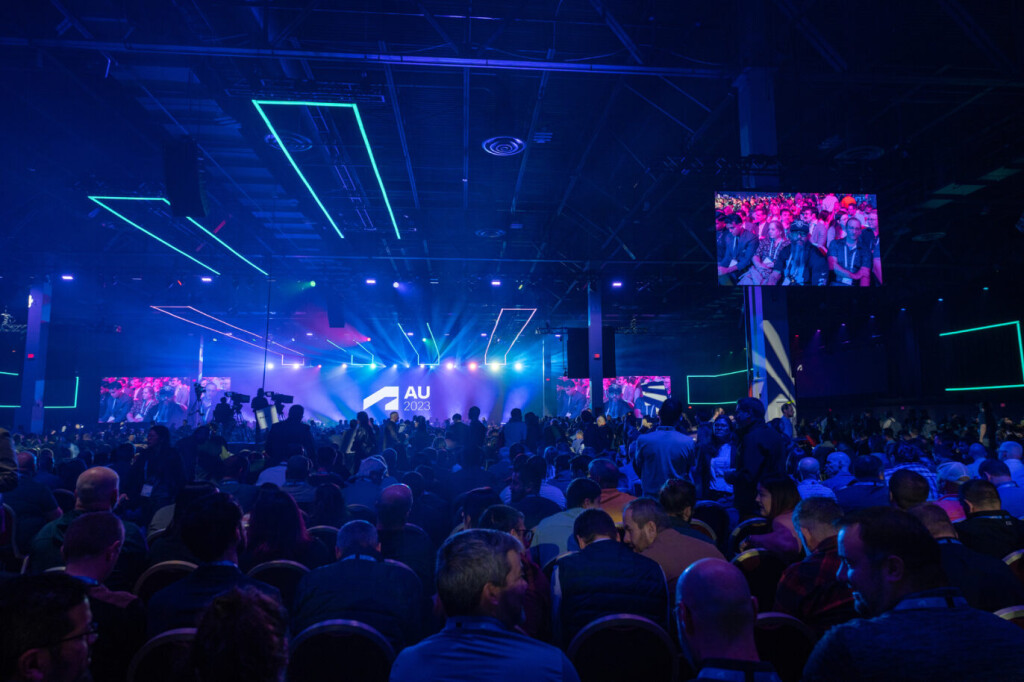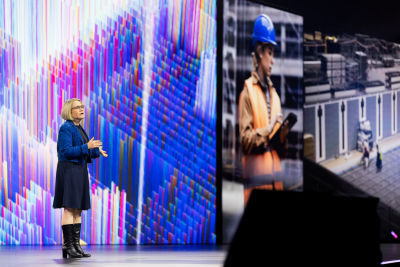Earlier this month at the Venetian Resort in Las Vegas, Nevada, Autodesk held Autodesk University, the company’s annual conference for users and other professionals in the worlds of AEC, design & manufacturing, and media & entertainment. Through the three-day event, the company reports over 12,000 global attendees in-person, with nearly 200 exhibitors on the expo floor and over 600 classes and learning sessions available for those in attendance.
Geo Week News was among those in attendance for this year’s event, taking in all of the different aspects of the show. There were a variety of sessions touching on a range of topics including new workflows around BIM models, implementing GIS into construction projects, making the most of digital twins, getting past technological fatigue, and more. There were also opportunities for media to speak with executives from the Autodesk team, keynotes that featured executives as well as a 30-minute conversation with actor (and man of many other titles) Ryan Reynolds, and to check out an expo floor filled with Autodesk partners across industries and ranging in all scopes and sizes.
A bit less than a week removed from the end of this year’s event, here are a few of the biggest takeaways from Autodesk University 2023.
AI remains top of mind
At this point, it doesn’t matter what specific vertical you’re talking about - if you’re at a conference for any industry that has anything remotely to do with technology, a significant portion of your conversations are going to revolve around artificial intelligence. This year’s Autodesk University was certainly no exception, as it was easily the number one topic of conversation coming from Autodesk team members, exhibitors, and attendees alike. In fact, the biggest announcement made throughout the week was the introduction of the company’s new Autodesk AI offering.
Throughout the event, including during the opening day keynote during which President and CEO Andrew Anagnost officially introduced Autodesk AI, everyone made clear that AI in general is not a new foray from Autodesk. This is a common refrain you’ll hear in many of these conversations, and it’s true. Automated workflows and artificial intelligence have been part of tech’s offerings for years, certainly including Autodesk. There is certainly some capitalizing on hype from all of these new releases, but also much more powerful capabilities, largely centering around generative AI.

In Autodesk’s case, they are offering new generative capabilities that can be used across their customer base, which include a diverse set of professionals. Focusing particularly on AEC, Autodesk AI promises to automate the most tedious tasks – something that is increasingly important as the workforce issues only get worse – with much of the focus here being put on AI’s capabilities in Autodesk Forma. Executives were also clear in saying workers shouldn’t worry about losing their jobs to AI, but rather take to heart that these new tools will simply augment their roles and allow them to do more creative work and complete projects more efficiently.
“I believe that AI should augment you, not replace you. That’s why over the next year we’re expanding the already powerful AI capabilities in Forma,” said Amy Bunszel, EVP of AEC Design Solutions. “Forma will fundamentally change the way you work. That is the power of Autodesk AI.”
The focus on AI was not just coming from the Autodesk team, either. It was a constant theme walking around the expo floor as well, with exhibitors showing off their latest automated capabilities. Take Nearmap, for example. The aerial imagery company gave Geo Week News a demo of their product, showing off their new AI capabilities for identifying assets – like roof types, vegetation, swimming pools, etc. BIMLOGIQ was also on the floor, showing attendees their AI solution to quickly annotate and analyze BIM models.
Mixed reality has arrived
While AI was very clearly the dominant topic at this year’s Autodesk University, the arrival of mixed reality shouldn’t be ignored, either. It’s, of course, not that XR workflows were not existent prior to 2023, but the sheer number of solutions everywhere you looked in Las Vegas this year was somewhat staggering. And again, much of that revolved around an Autodesk product announcement, Autodesk Workshop XR.
This is one we covered earlier this week, and the tone of the conversations through the week was that this was just the beginning. Right now, the tool is designed for collaboration around design review, adding spatial context for multiple stakeholders to help catch potential design errors earlier in the process. Eventually, though, we could see other uses for XR in AEC workflows, both in the office and in the field. Even now, though, there are powerful capabilities, as was seen via demonstrations available from the Autodesk team on the expo floor.

And speaking of the Expo floor, it seemed like everywhere you looked there was some kind of XR solution being shown off by exhibitors. There was the aforementioned Autodesk demo area, but also companies like XYZ, vGIS, GAMMA AR, and many more with their own mixed reality workflows available today with headsets, mobile devices and tablets, or both.
Integration is key
Aside from the specific tools like AI and XR, the biggest takeaway from sitting in sessions and speaking with people at Autodesk University was the importance of integrations due to the sheer number of solutions and tools available on the market right now. That point was hammered home by the whopping 198 exhibitors on the expo floor at this year’s event, all of whom have something to offer to their industry.
It’s great to have so many tools, but it can also be a challenge to keep up with this many tools, to say nothing of the lift of maintaining all of your project data when it’s all on different platforms. That’s why integration is such an important topic, and something discussed throughout the event, including in sessions. There is one session in particular – Managing Tech Fatigue in an Emerging Tech Industry – in which professionals told their own stories of organizations juggling many different solutions and how they were able to derive the most value out of them. Geo Week News also caught up with Topcon Solutions on the Expo floor, where they were showing off their Aptix solution – their integration-platform-as-a-service offering – to address this very issue.
A new era is here
Above all else – even specifics like AI and XR – the biggest takeaway from spending three days in Las Vegas around some of the most innovative and forward-thinking members of the AEC industry was that we are officially in a new era. For so long many technologies – including AI and XR – were spoken about theoretically, as things off in the future that will someday help professionals streamline their work. This year, those solutions were on display and available today. The future has certainly arrived.
“We want to help you begin the design process where your thoughts are, not where your mouse is. That’s why our Design and Make Platform is powered by Autodesk AI,” Anagnost said in his keynote address. “And just like it’s been doing for the last ten years, it’s enabling a future that’s already happening. A future that’s already expanding our capabilities and our imaginations. Enabling better workflows, better outcomes, a better world. Because we believe all of you can make anything.”







